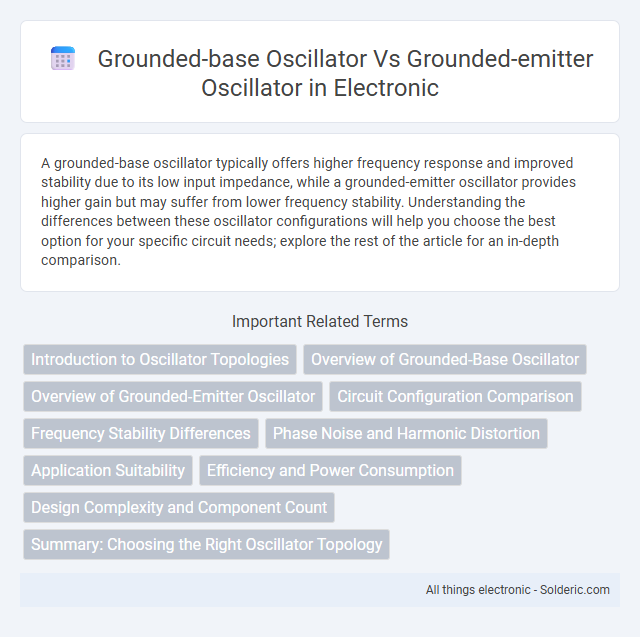A grounded-base oscillator typically offers higher frequency response and improved stability due to its low input impedance, while a grounded-emitter oscillator provides higher gain but may suffer from lower frequency stability. Understanding the differences between these oscillator configurations will help you choose the best option for your specific circuit needs; explore the rest of the article for an in-depth comparison.
Comparison Table
| Feature | Grounded-Base Oscillator | Grounded-Emitter Oscillator |
|---|---|---|
| Configuration | Base terminal grounded | Emitter terminal grounded |
| Input Impedance | Low input impedance | Moderate input impedance |
| Output Impedance | High output impedance | Moderate output impedance |
| Voltage Gain | Lower voltage gain | Higher voltage gain |
| Current Gain | Higher current gain | Lower current gain |
| Phase Shift | 180deg phase shift | 180deg phase shift |
| Frequency Stability | Good frequency stability | Moderate frequency stability |
| Application | High-frequency oscillators, RF circuits | Audio frequency oscillators, general purpose |
| Biasing Complexity | Simple biasing network | More complex biasing required |
Introduction to Oscillator Topologies
Grounded-base oscillators feature the transistor base connected to ground, enabling high-frequency stability and low input impedance, ideal for RF applications. Grounded-emitter oscillators have the emitter grounded, offering moderate gain with straightforward biasing and are commonly used in audio frequency circuits. Both topologies impact oscillator performance by influencing parameters like frequency stability, gain, and impedance matching.
Overview of Grounded-Base Oscillator
The Grounded-Base oscillator features the transistor base connected to ground, enhancing frequency stability and simplifying biasing configurations compared to other oscillator types. This configuration provides low input impedance and high output impedance, which is ideal for high-frequency oscillations in RF circuits. Its design enables efficient feedback and oscillation with minimal distortion, making it suitable for applications requiring stable, high-frequency signal generation.
Overview of Grounded-Emitter Oscillator
Grounded-emitter oscillators feature the emitter terminal connected directly to ground, enabling high current gain and stable oscillation frequency. These oscillators are widely used in radio frequency generation due to their simplicity and efficient feedback mechanism through the base-collector junction. Their design offers better voltage stability compared to grounded-base configurations, making them suitable for amplification and signal generation in low to medium frequency applications.
Circuit Configuration Comparison
The grounded-base oscillator features its base terminal connected to the reference ground, resulting in low input impedance and high voltage gain suitable for high-frequency applications. In contrast, the grounded-emitter oscillator grounds the emitter terminal, offering moderate input impedance and stable biasing conducive to general-purpose oscillation with better thermal stability. Both configurations differ mainly in input/output impedance and gain, influencing their frequency response and application in RF and audio signal generation circuits.
Frequency Stability Differences
Grounded-base oscillators exhibit higher frequency stability due to lower input capacitance and reduced feedback sensitivity, which minimizes variations caused by temperature or component tolerances. Grounded-emitter oscillators, while simpler in design, tend to have less frequency stability because the emitter's reactance influences the oscillation frequency more significantly under varying conditions. Your choice depends on whether precision frequency control or circuit simplicity is the priority.
Phase Noise and Harmonic Distortion
Grounded-base oscillators exhibit lower phase noise due to their higher input impedance and reduced parasitic capacitances, enabling more stable frequency generation compared to grounded-emitter oscillators. Harmonic distortion is typically less in grounded-base configurations because the transistor operates with a fixed base voltage, minimizing nonlinearities that cause signal distortion. Grounded-emitter oscillators, while simpler and providing higher gain, generally produce higher phase noise and greater harmonic distortion, impacting overall signal purity.
Application Suitability
Grounded-base oscillators are suitable for high-frequency applications due to their low input impedance and high stability, making them ideal for RF signal generation and communication systems. Grounded-emitter oscillators offer greater voltage gain and better phase shift characteristics, fitting well in audio frequency oscillators and general-purpose signal generation. Selection depends on the frequency range and impedance matching requirements of the intended electronic circuit application.
Efficiency and Power Consumption
Grounded-base oscillators typically exhibit higher frequency stability but consume more power due to increased base current, leading to lower efficiency compared to grounded-emitter oscillators. Grounded-emitter oscillators offer improved efficiency as the emitter is common and can provide better gain with lower power consumption. Power optimization in oscillator design often favors the grounded-emitter configuration for low-power applications without compromising signal integrity.
Design Complexity and Component Count
Grounded-base oscillators typically exhibit lower design complexity due to their stable input impedance and fewer external components, making them suitable for high-frequency applications. Grounded-emitter oscillators involve higher design complexity with increased component count, as biasing networks and stabilization elements are necessary to maintain proper operation and signal integrity. The grounded-base configuration minimizes the need for additional resistors and capacitors compared to grounded-emitter circuits, which require more components to control gain and prevent distortion.
Summary: Choosing the Right Oscillator Topology
Grounded-base oscillators offer higher stability and better high-frequency performance, making them ideal for RF applications where minimal phase noise is crucial. Grounded-emitter oscillators provide greater voltage gain and simpler biasing, suited for lower frequency ranges and general-purpose signal generation. Selecting the right oscillator topology depends on frequency requirements, stability needs, and circuit simplicity, with grounded-base favored in high-frequency designs and grounded-emitter preferred for versatility and ease of implementation.
Grounded-base oscillator vs Grounded-emitter oscillator Infographic

 solderic.com
solderic.com